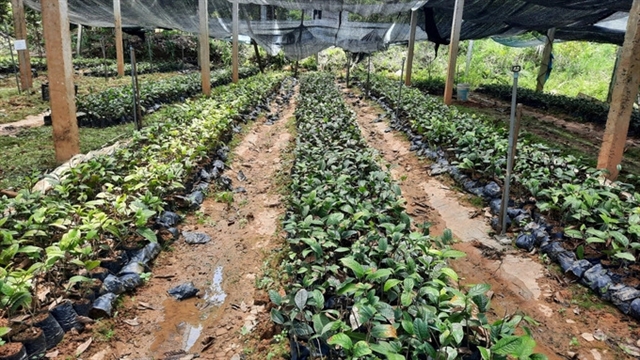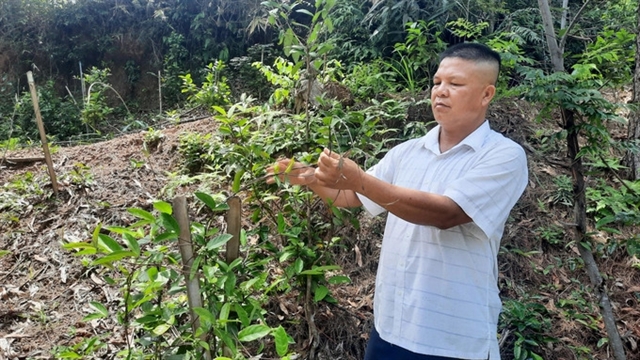 Society
Society


|
| A medicinal plant garden in Ba Chẽ District, Quảng Ninh Province. — Photo nongnghiep.vn |
QUẢNG NINH — With 70 per cent of its natural area made up of mountains and forests, Quảng Ninh has a great advantage for localities to exploit the resources for economic development under the forest canopy, especially medicinal herbs.
The province, in recent years, has restructured its forestry sector to gain sustainable forestry development and transform its growth model towards enhancing quality, efficiency and competitiveness.
Particularly, the forest sector has focused on protecting, planting forests and creating income from forests for local people.
With over 100,000ha of natural forests and 200,000ha of planted forests, Quảng Ninh has planned three key areas for the development of medicinal herbs.
Accordingly, Bình Liêu and Tiên Yên districts and Móng Cái City, have focused on growing anise, cinnamon, honeysuckle and other medicinal plants.
Golden camellia plant, ba kích (Morinda officinalis), ginseng, cinnamon and some other medicinal species have been mainly planted in Ba Chẽ and Cẩm Phả districts.
Meanwhile, đinh lăng (polyscias fruiticose), gấc (Momordica cochinchinensis), ginseng and turmeric have been mainly growing in Uông Bí, Đông Triều districts and Hạ Long City.
Home to nearly 1,000 medicinal plant species, Quảng Ninh Province is implementing solutions to turn herbal medicine development into one of the economic priorities so as to tap into local advantages, becoming a medicinal centre of the northeast region and the country.
In addition to developing medicinal plants, the province has also paid attention to seedlings, preserving high-yield and good-quality forest product varieties to build seedling nurseries in localities and encourage all economic sectors to invest in the development of non-timber forest products.
The localities have effectively implemented a number of economic development models under the forest canopy, improving the value of forests and increasing incomes for local residents.
Ba Chẽ District is a typical example.
With an area of 91 per cent forestry land, the district has been oriented to become one of the provincial and regional green medicinal centres.
The local has also planned areas for growing medicinal plants and implemented the project on conservation and development of medicinal herbs for the 2021-25 period, striving to plant more than 100 hectares of new medicinal plants per year.
The production model associated with preserving, processing and consuming medicinal herbs in the northern mountainous region for the 2018-20 period had also been built in Thanh Lâm Commune.
The ba kích plants (Morinda officinalis) were intercropped under the canopy of acacia, dổi and fruit trees with a yield of five tonnes per ha.

|
| Nịnh Văn Trắng with his ba kích (Morinda officinalis) plants grown under the forest canopy in Ba Chẽ District. — Photo nongnghiep.vn |
Nịnh Văn Trắng, a farmer from Đạp Thanh Commune, Ba Chẽ District, said he was looking after 7ha of golden camellia plant, 5ha of ba kích and 2ha of ginseng which were cultivated under the forest canopy.
These trees are very suitable for the local soil and climate, helping people to develop production on an area of forestry land.
Head of the Ba Chẽ District's agriculture and rural development sub-department, Vi Thanh Vinh, said the economic development under the forest canopy has increased incomes, improved people's living standards, and ensured long-term local socio-economic development, especially ensuring income for households who cultivate perennial and big trees.
Last month, the provincial People's Committee also issued a plan on developing and processing of agricultural, forestry and fishery products in association with promoting market development to 2025, with an orientation to 2030.
Accordingly, the forestry sector will focus on developing the production and processing of key agricultural, forestry and fishery products of the province, ensuring high quality, food safety, creating added value and participating in the production chain, meeting the increasingly stringent standards of domestic and international markets.
The plan also aims to ensure the target of agricultural export growth in association with the goal of sustainable agricultural product development; apply science and technology, digitise production and processing as well as improve the competitiveness of local agricultural products.
To develop the economy under the forest canopy, the province will promote research and extraction of bioactive compounds to serve the chemical and pharmaceutical industries; research and test products with economic value from medicinal by-products.
At the same time, the province will also prioritise attracting investment, improving productivity, quality and efficiency of large and medium-scale processing, applying advanced technology and modern processing equipment to synchronise with concentrated production areas.
Quảng Ninh is continuing to expand the planting area and its dominant medicinal plants. It is expected that in the 2021-25 period, the total area of medicinal plants will reach over 16,500 hectares. — VNS




